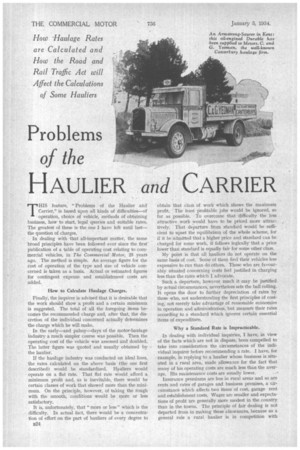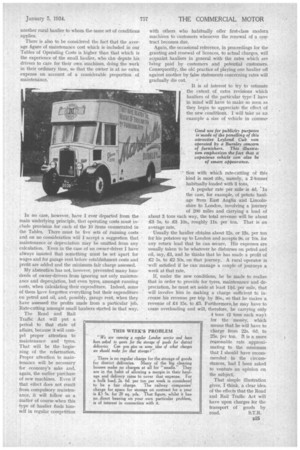Problems of the
Page 38

Page 39

If you've noticed an error in this article please click here to report it so we can fix it.
HAULIER and CARRIER THIS feature, "Problems of the Haulier and Carrier," is based upon all kinds of difficulties—of operation, choice of vehicle, methods of obtaining business, how to start, legal queries and suitable rates. The greatest of these is the one I have left until last— the question of charges.
In dealing with that all-important matter, the same broad principles have been followed ever since the first' publication of a table of operating cost relating to commercial vehicles, in The Commercial Motor, 25 years ago. The method is simple. An average figure for the cost of operation of the type and size of vehicle concerned is taken as a basis. Actual or estimated figures for contingent expense and establishment costs are added.
How to Calculate Haulage Charges.
Finally, the inquirer is advised that it is desirable that the work should show a profit and a certain minimum is suggested. The total of all the foregoing .items becomes the recommended charge and, after that, the discretion of the individual concerned actually determines the charge which he will make.
In the early—and palmy—days of the motor-haulage industry a much simpler course was possible. Then the operating cost of the vehicle was assessed and doubled. The latter figure was quoted and usually obtained by the haulier.
If the haulage industry was conducted on ideal lines, the rates calculated on the above basis (the one first described) would be standardized. Hauliers would operate on a flat rate. That flat rate would afford a minimum profit and, as is inevitable, there would be certain classes of work that showed more than the minimum. On the principle, however, of taking the rough with the smooth, conditions would be more or less satisfactory.
It is, unfortunately, that "more or less" which is the difficulty. In actual fact, there would be a concentration of effort on the part of hauliers of every degree to B24 obtain that class of work which shows the maximum profit. The least profitable jobs would be ignored, so far as possible. To overcome that difficulty the less attractive work would have to be priced more attractively. That departure from standard would be sufficient to upset the equilibrium of the whole scheme, for if it be admitted that a higher price and standard can be charged for some work, it follows logically that a price lower than standard is equally fair for some other class.
My point is that all hauliers do not operate on the same basis of cost. Some of them find their vehicles less expensive to run than do others. Those who are favourably situated concerning costs feel justified in charging less than the rates which I advocate.
Such a departure, however much it may be justified by actual circumstances, nevertheless sets the ball rolling. It opens the door to further depreciation of rates by those who, not understanding the first principles of costing, not merely take advantage of reasonable economies in operation and administration, but measure their rates according to a standard which ignores certain essential items of expenditure.
Why a Standard Rate is Impracticable.
In dealing with individual inquiries, I have, in view of the facts which are not in dispute, been compelled to take into consideration the circumstances of the individual inquirer before recommending a rate. I have, for example, in replying to a haulier whose business is situated in a rural area, made allowance for the fact that many of his operating costs are much less than the average. His maintenance costs are usually lower.
Insurance premiums are less in rural areas and so are rents and rates of garages and business premises, a circumstance which affects two items of cost, garage rent and establishment costs. Wages are smaller and expectations of profit are generally more modest in the country than in the towns. The principle of fair dealing is not departed from in making these allowances, because as a general rule a rural haulier is in competition with another rural haulier to whom the same set of conditions applies.
There is also to be considered the fact that the average figure of maintenance cost which is included in our Tables of Operating Costs is higher than that which is the experience of the small haulier, who dm depute his drivers to care for their own. machines, doing the work in their ordinary time, so that the owner is at no extra expense on account of a considerable proportion of maintenance.
In no case, however, have I ever departed from the main underlying principle, that operating costs must include provision for each of the 10 items enumerated in the Tables. There must be five sets of running costs and on no consideration will I accept a suggestion that maintenance or depreciation may be omitted from any calculation. Even in the case of an owner-driver I have always insisted that something must be set apart for wages and for garage rent before establishment costs and profit are added and the minimutn fair charge assessed.
My abstention has not, however, prevented many hundreds of owner-drivers from ignoring not only maintenance and depreciation, but even tyres, amongst running costs, when calculating their expenditure. Indeed, some of them have forgotten everything but their expenditure on petrol and oil, and, possibly, garage rent, when they have assessed the profits made from a particular job. Rate-cutting amongk small hauliers started in that way.
The Road and Rail Traffic Act will put a period to that state of affairs, because it will compel proper attention to maintenance and tyres. That will be the beginning of the reformation. Proper attention to maintenance will be necessary for .economy's sake and, again, the earlier purchase of new machines. Even if that effect does not result from compulsory maintenance, it will follow as a matter of course when this type of haulier finds himself in regular competition with others who habitually offer first-class modern machines to customers whenever the renewal of a con tract becomes due.
Again, the occasional reference, in proceedings for the granting and renewal of licences, to actual charges, will acquaint hauliers in general with the rates which are being paid by customers and potential customers. Consequently, the old practice of playing one haulier off against another by false statements concerning rates will gradually die out. It is of interest to try to estimate the extent of rates revisions which hauliers of the particular type I have in mind will have to make so soon as they begin to appreciate the effect of the new conditions. I will take as an example a size of vehicle in connee tion with which rate-cutting of this kind is most rife, namely, a 2-tonner habitually loaded with 3 tons.
A popular rate per mile is 4d. • In the case, for example, of potato haulage from East Anglia and Lincolnshire to London, involving a journey of 200 miles and carrying a load of about 3 tons each way, the total revenue will be about £3 5s. to £3 10s., roughly 1.1s, per ton. That is an average rate.
Usually the haulier obtains about 12s. or 13s. per ton for his potatoes up to London and accepts 95. or 10s. for any return load that he can secure. His expenses are usually taken to be whatever he disburses on petrol and oil, say, £1, and he thinks that he has made a profit of £2 5s. to £2 10s. on that journey. A rural operator is well satisfied if he can manage a couple of journeys a week at that rate.
If, under the new conditions, lie be made to realize that in order to provide for tyres, maintenance and depreciation, he must set aside at least Ild. per mile, that will involve him in making a charge sufficient to increase his revenue per trip by 30s., so that he makes a revenue of £4 15s. to £5. Furthermore, he may have to cease overloading and will, therefore, be carrying only 4 tons (2 tons each way) for the money, which means that he will have to charge from 22s. 6d. to 25s. per ton. ft is a more reasonable rate approximating to the minimum that I should have recommended in the circumstances, had I been asked to venture an opinion on the subject.
That simple illustration gives, I think, a clear idea of the effects that the Road and Rail Traffic Act will have upon charges for the transport of goods by road. S.T.R.




























































































